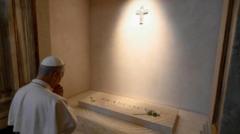Chicago's lakefront is notorious for being hazardous to migrating birds. A recent initiative at McCormick Place seeks to mitigate this threat, transforming a deadly environment into a safer passage for these travelers.
Chicago's Glass Building Transformation: A Lifeline for Migratory Birds

Chicago's Glass Building Transformation: A Lifeline for Migratory Birds
New protective measures at McCormick Place conference center aim to reduce bird fatalities during migration season.
As dawn broke over Chicago, a flurry of migratory birds took to the skies, racing across one of the most perilous segments of their annual journey. Late April marks peak migration time, with flocks of small birds millions strong navigating the city’s skyline, which poses a grave risk due to its glass-clad buildings. The captivating reflections and city lights serve as daring lures, leading these forest and grassland dwellers to unfortunate collisions.
Among Chicago’s notorious avian hazard hotspots is the McCormick Place conference center, which tragically accounted for nearly a thousand bird deaths in a single day last October. However, this year, a concerted effort to protect these vulnerable migrants has taken shape. Volunteers throughout the city were alerted to prepare for an early morning mission to save any birds they could and catalog those that met with misfortune.
In a significant step forward, the windows of the McCormick Place conference center now feature a specialized pattern designed to offer enhanced visibility to the birds, significantly reducing their likelihood of crashing into the glass. This initiative signifies part of a broader campaign under the “50 States, 50 Fixes” series, which explores localized solutions to pressing environmental issues. Chicago's glass buildings may long be a danger for migratory birds, but with proactive measures in place, the city aims to turn a lethal landscape into a more hospitable environment for these flight-bound travelers.





















